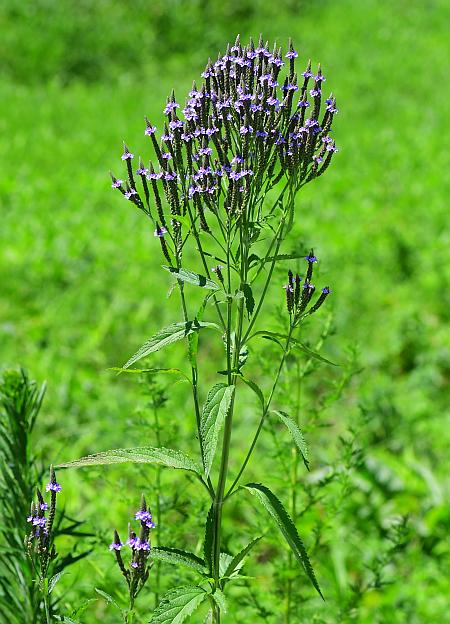Verbena hastata L.
Blue Vervain

Native
CC = 4
CW = -3
MOC = 66
© SRTurner
Verbena hastata L.Blue Vervain | |
 |
Native CC = 4 CW = -3 MOC = 66 |
© SRTurner |
|
Family - Verbenaceae Habit - Perennial forb. Stems - Strongly ascending to erect, to 1.5 m, 4-angled, branched above, moderately to densely pubescent with nonglandular, somewhat curved, loosely ascending to appressed, often pustular-based hairs.
Leaves - Opposite, simple, petiolate. Petioles mostly 10-25 mm long, usually winged toward the tip. Blades 4-20 cm long, those of the largest leaves 15-45 mm wide, lanceolate to narrowly ovate, rounded, angled, or short-tapered to a nonclasping base, tapered to a sharply pointed tip, unlobed or the larger leaves with a pair of spreading basal lobes, the margins relatively coarsely and doubly toothed, both surfaces glabrous or sparsely to moderately, but inconspicuously pubescent with short, loosely appressed, nonglandular, occasionally pustular-based hairs, not appearing grayish, sometimes roughened to the touch.
Inflorescence - Panicles of 5 to numerous spikes, these 2-20 cm long, moderately dense, most flowers strongly overlapping, appearing stout when young but relatively slender at maturity, elongating greatly with age. Bracts 2.0-2.5 mm long, slightly shorter than the calyx, narrowly lanceolate.
Flowers - Calyces 2.3-3.0 mm long, tubular, pubescent, 5-lobed. Corollas 6-10 mm long, the outer surface sparsely to moderately hairy near the tip of the tube, funnelform, usually purplish blue, the tube slightly broadened toward the tip, the limb 3.0-4.5 mm in diameter. Stamens 5, included within corolla. Ovary 4-locular, slightly concave at the tip. Style 2-3 mm long, the sterile lobe not extending beyond the fertile lobe, flattened and triangular.
Fruits - Nutlets 1.5-2.0 mm long, narrowly oblong to narrowly oblong-elliptic in outline, the inner surface usually slightly pale and with sparse to moderate, minute, appressed hairs, the outer surface reddish brown, smooth or with several faint longitudinal ridges, these sometimes with a few, faint cross-ridges toward the tip. Flowering - June - October. Habitat - Streambanks, margins of ponds and sloughs, bottomland and mesic forests, prairies, fens, ledges of bluffs, fencerows, fields, ditches, railroads, roadsides, open disturbed areas. Origin - Native to the U.S. Lookalikes - V. stricta. Other info. - This species is found throughout most of Missouri, though less commonly in the Ozark region. It also occurs across most of the continental U.S. but is by far more common in the northern half of the country and east of the Rockies. Plants with well developed inflorescences are fairly striking, and easily identified by the appearance of the inflorescence. Some individuals can appear similar to V. stricta, but the latter is usually a somewhat shorter plant with larger flowers, fewer inflorescence branches, and nearly sessile leaves. V. hastata is most commonly found in moist to wet areas. Though usually tall, it can bloom when quite small if mowed or cut frequently. Photographs taken off Shaw Ave., St. Louis, MO., 7-28-03 (DETenaglia); also at Shaw Nature Reserve, Franklin County, MO, 7-20-2007, Weldon Spring Conservation Area, St. Charles County, MO, 8-13-2014, and Riverfront Park, Washington, Franklin County, MO, 7-12-2020 (SRTurner). |